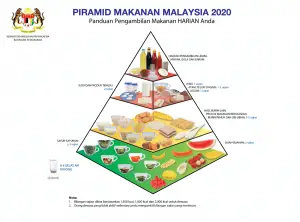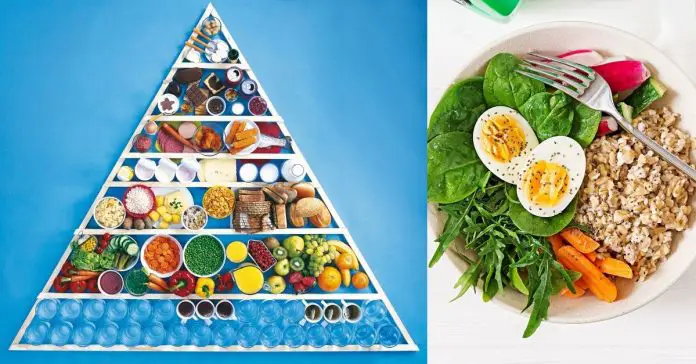We’re not sure if you’ve noticed, but our food pyramid has quite recently undergone a change. If you were still in primary school some 10-20 years ago, you might remember that in PJK classes, the food pyramid stared up at you in the textbook. (Because that’s all I remember from the classes, actually.) The first official Malaysian Dietary Guidelines (MDG) was published in 1999, and subsequently revamped in 2010, and then in 2020 again. If you remember the food pyramid back then, the base of it was totally occupied by rice and other grains. Not anymore, but let’s take a look at the new Malaysian food pyramid!
What’s A Food Pyramid?
Simply put, a food pyramid is a visual tool and guide that helps one maintain a healthy diet. As you might have guessed, the food pyramid is in the shape of a pyramid, with a large base and pointed top. The Malaysian food pyramid is currently divided into four levels representing various food groups, and we should consume more food that’s included in the base, and less food at the pointy top. Alongside the food groupings, the food pyramid also indicates the amount we should be consuming in terms of serving size.

(softly whispers) But What’s A Serving Size?
I didn’t bother to find out till I had to write this article, and even then it’s not very helpful, to be completely honest. A serving size is the recommended amount of food consumed daily in household measurements of food and beverages, such as cup, plate, ounce, bowl, tablespoon etc. Most often, the labels on food products depict serving sizes, but a Malaysian recommended serving size may not necessarily match up with a serving size on the food labels. Serving sizes can differ by countries or (health) organisations. I’m no nutritionist or dietary expert, but my serving sizes mainly consist of “fine, give me more fruit and vegetables”, “less rice please”, and “[drink] kosong” to name a few. I think it works well for me at least.

The Malaysian Food Pyramid 2020
To simplify everything, take a look at this image, taken from the Ministry of Health’s official portal:

And a list for those who prefer it:
- Fat, salt, sugar: reduce and limit intake
- Milk & milk (dairy) products: 1-2 servings
- Legumes & nuts: 2-3 servings
- Fish: 1 serving
- Poultry/meat/eggs: 1-2 servings
- Rice, cereals, cereal-based products (preferably wholegrain), and tubers: 3-5 servings
- Vegetables: At least 3 servings
- Fruits: 2 servings
- Plain water: 6-8 servings
*Note: Servings are stated as daily intake.
Do We Really Need To Follow The Food Pyramid?
Well… it’s not a law, but it’s a good place to start if you need a guide for healthy eating. Malaysia’s obesity rate has been on the rise, and is also known as “Asia’s fattest country”, so it’s high time we really take a good look at our lifestyle. There are also many types of diets out there, and what works for you may not work for another, and sometimes nutritionists don’t recommend going on “diets” because healthy eating habits are more sustainable in the long run–diets will make you “relapse” into unhealthy eating habits if you had them in the first place. Eat for enjoyment, definitely, and don’t overly restrict yourself, but remember that you also have your health to take care of.

Obesity & Fat Shaming
For a while, some people actually believed that fat shaming was a good way to help people lose weight, but research shows that it actually had the opposite effect. Fat shaming, or any sort of shaming, really, has a negative effect on the person, and can lead to anxiety, depression and other feelings. To escape these feelings, they might turn to something that makes them feel good–possibly eating. It then turns into a vicious cycle, and some rightly say that if fat shaming is a legitimate method, there would probably be no fat people. It is a touchy subject to talk about, especially if you know of someone that is obese (and has health risks), and would like to encourage them to lose weight to stay healthy. Be respectful and non-judgemental, and try to approach the subject from a health perspective, rather than a weight perspective.

And that’s it for the latest version of the Malaysian food pyramid, the 2020 version! Do you find food pyramids helpful, or do you have a different guide you follow, or do you just wing your food intake? Let us know, but most importantly, as long as it makes you happy and healthy!















